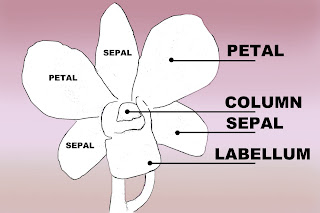 With the spotlight on Thailand, I though it appropriate to post some information on Dendrobium, which is the principal flower that we purchase from that country.
With the spotlight on Thailand, I though it appropriate to post some information on Dendrobium, which is the principal flower that we purchase from that country.It seems that the rioting and urban warfare has been suspended while an accord is worked out that is acceptable to both sides. However, curfews continue throughout Bangkok and the surrounding provinces.
We all hope that peace will return to this spiritual country as soon as possible.
Dendrobium, as we know them in the commercial cut flower trade, are incredibly popular due to the fact that they can be deployed in a wide range of design situations; they have attractive flowers; they come in a range of pastel colors and jewel tones ; and they are very attractively priced.
 If you ever go on vacation to a sunny locale with azure seas and white beaches, more often than not the local Tiki bar sertves up attractive frou-frou drinks with little parasols, fruit garnishes and dendrobium flowers.
If you ever go on vacation to a sunny locale with azure seas and white beaches, more often than not the local Tiki bar sertves up attractive frou-frou drinks with little parasols, fruit garnishes and dendrobium flowers. Health tip: Ask the bartender to hold the floral highlight. Moreover, one should never use these flowers to adorn wedding cakes or any other foodstuff targeted for human consumption.
 These orchids are grown in very humid sub-tropical zones, generally outdoors, perhaps with a little shadecloth providing the only cover, and where pesticides are obligatory to maintain the level of insect-free criteria required by USDA. Generally wherever the dendrobium are grown there is a high incidence of chewing insects drawn to these enticing flowers.
These orchids are grown in very humid sub-tropical zones, generally outdoors, perhaps with a little shadecloth providing the only cover, and where pesticides are obligatory to maintain the level of insect-free criteria required by USDA. Generally wherever the dendrobium are grown there is a high incidence of chewing insects drawn to these enticing flowers.  Dendrobium is family of orchids that numbers some 1,000+ varieties whose original habitat is a region of southern Asia and the South Pacific that ranges from India in the west to Fiji in the east; from Southern Japan in the north to New Zealand in the south. They are also widely dispersed from sub-tropical sea-level environments to the temperate climes found in the foothills of the Himalayas and the mountains of New Caledonia.
Dendrobium is family of orchids that numbers some 1,000+ varieties whose original habitat is a region of southern Asia and the South Pacific that ranges from India in the west to Fiji in the east; from Southern Japan in the north to New Zealand in the south. They are also widely dispersed from sub-tropical sea-level environments to the temperate climes found in the foothills of the Himalayas and the mountains of New Caledonia. Of the many hundreds of species only about 170 have been used for hybridization, and most of these for esoteric plants. With respect to the commercial cut-flower market; barely thirty species have been used in the hybridization of new varieties. Most of the cut Dendro are derived from three principal dendrobium species and an early hybrid from 1929, namely Dendrobium phalaenopsis; D. Nobile; D. bigibbum; and D. "Louis Bleriot".
Of the many hundreds of species only about 170 have been used for hybridization, and most of these for esoteric plants. With respect to the commercial cut-flower market; barely thirty species have been used in the hybridization of new varieties. Most of the cut Dendro are derived from three principal dendrobium species and an early hybrid from 1929, namely Dendrobium phalaenopsis; D. Nobile; D. bigibbum; and D. "Louis Bleriot". If you have been in the flower business since 1980 you will recall the ubiquitous D. "Pompadour", which continues to be cultivated to this day. This was developed in Australia in the late '60s and was then cultivated extensively in Thailand in the '70s and '80s. The real explosion in dendrobium culture was the application of meristem tissue culture, which allowed for the dvelopment of millions of plants in just a few years. Before the 1980s such a rollout would have taken decades, which is why orchids remained the exclsuive domain of plant collectors and orchid enthusiasts.
If you have been in the flower business since 1980 you will recall the ubiquitous D. "Pompadour", which continues to be cultivated to this day. This was developed in Australia in the late '60s and was then cultivated extensively in Thailand in the '70s and '80s. The real explosion in dendrobium culture was the application of meristem tissue culture, which allowed for the dvelopment of millions of plants in just a few years. Before the 1980s such a rollout would have taken decades, which is why orchids remained the exclsuive domain of plant collectors and orchid enthusiasts.The dendro we use in our work come from a limited group that are called "soft-cane", which refers to the thin long stems that the flowers are borne on. In actual fact most dendro are borne on thick, woody stems, with the flowers borne more compact racemes, with a wide range of color, many featuring variegations and alternate colored striations. Another attribute missing from commercial dendro is that of fragrance, an aspect that I expect to be introduced into the hybrid culture within ten years.
But for now, we hope that Thailand enjoys once again the peace and serenity that these flowers are so often associated with.

No comments:
Post a Comment